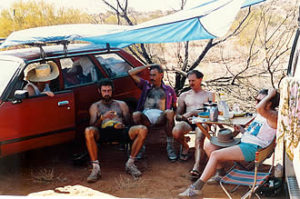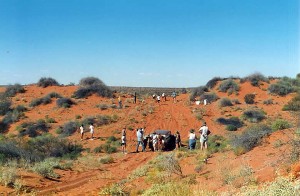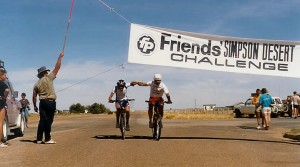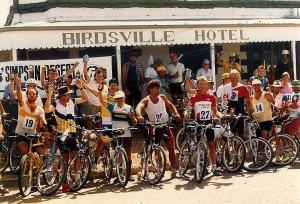The 1987 Inaugural Simpson Desert Classic included entrants as young as 13 riding BMX bikes. One of them finished all the stages. The race was shortened to six stages because of unrideable conditions. This was because the course followed the French Line which features deep sand for much of it’s length.
Desert Challenge Fat-tyre competition
Mountain bikers race across the desert to Birdsville
Article from Freewheeling magazine July/August 1987
Story by Ray Peace (Photos provided separately by Leon Fisher )
The Simpson Desert, the driest and toughest of Australia’s unforgiving Red Centre, has yet to be conquered by bicycle.
No one rider has yet succeeded in making the west-east crossing to Birdsville from South Australia on an ATB. The first organised attempt to subdue one of the last bastions of unpedalled Australia was made over Easter this year with the Simpson Desert Cycle Challenge. Thirty riders from all over Australia took up the Challenge, organised by well known adventurer Hans Tholstrup, and sponsored by Caltex and Friends Provident Life insurance.
Thirty entrants, and in most cases their support crews, made their way to a lonely spot called Alka Seltzer Bore, by way of Oodnadatta, for the Saturday morning start. The cyclists involved came from all the eastern mainland States. To be part of the Challenge each paid a $300 entry fee, which covered catering, water supplies (at $3 per litre), medical back-up and the officials.
Two riders, James Layton of Coffs Harbour and Mark Higley of Sydney, actually pedaled the 2500 kilometers to the western most sand dune of the Simpson. Birdsville was 370 kilometers to the east.
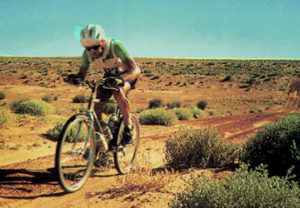
Hans brought everyone together for a pre-start lecture on what he called ‘my private sand pit’. “This desert is unforgiving”, Hans warned. “If you run out of water or feel you can’t make it, stop and wait for the sweep vehicle”. The sweep followed the last rider and collected laggers; it became known as “The Grim Reaper”.
Hans Tholstrup, born in Denmark, once set out to travel around the world, and found Australia so much to his liking that he stayed. The first Australian to make a round the world solo flight, and also to cross the Simpson on foot, along.
Hans based the planning for the Cycle Challenge on an earlier BMX relay crossing in 1982. Riders lined up in the dawn light in their colourful road-tops, sunburn cream and floppy hats, and roared off at 7.30am over the first of more than 1300 sand dunes.
The contestants themselves covered the spectrum of cycling experience from semi-professional to rank novice. At one end, riders like Phil McDonald of Victoria, holder of several penny-farthing endurance records. Peter Hansen of Canberra, 30, sponsored by Spokesman Cycles, with five years’ experience in amateur racing. Reg McVilly, another Victorian, the wiry holder of the Melbourne-Adelaide-Melbourne record.
But some were in it simply so they could say “I cycled in the Simpson Desert”. Ann-Liese Aumuller, aged 63, of Adelaide, and fellow South Aussie Arthur Conway were conducting an equally intense battle to reach the water stops, half-way through each 50 kilometer morning or 70 kilometer afternoon section, or just to stay ahead of the sweep. They didn’t always succeed. One novice who did very well was Leon(the fish) Fisher of Wudinna in South Australia. “Fish” had never been in a competitive or even touring ride in his life, but ran in the top three: “Difficult to ride with anyone else, when you live 260 kilometers from Port Augusta”, he observed.
The Challenge followed the Red Road, a track ploughed by oil drillers in the 1960’s. The cyclists bored across the flats between each dune, laboured in granny gears up to the crest, then slithered down the far side under brakes. The view from the top was the same each time, but different: low scrub, red sand, the dead straight track, a wash out, the next dune. NO two were exactly alike.
The Challenge also ran into problems on the first day. In the 1982 BMX crossing, the light racing BMXs with your teenage riders had been able to stay on top of the hard wind crust of the sand most of the time. The heavier ATBs with adults on board broke through and wallowed; some walked up to 10 kilometers A sand trap snared three backup four wheel drives in succession; beyond the afternoon water stop, steep 30 metre dunes with overhung crests, mocking any attempts to continue, Hans accepted a majority consensus to car life riders around this section. “People have just realised the Simpson Desert consists of sand”, he commented bitterly.
The Desert had clearly won the Challenge; the race to Birdsville, however, was still very much on. With a back track to the main Rig Road and a 180 kilometer car trip the cyclists went on. Peter Hansen established a handy lead early, and widened it on the long flat sections encountered heading south and east. Phil McDonald, running second, did better on the dunes and preferred them, but few riders agreed with him.
Some people had expected drifting Saharan like dunes, and had found semi permanent ones with bushes and grass. The cyclists as usual found the wildlife. Dingoes were curious by day and night at short distances; camels, less into scavenging, stayed well clear. The location of a stopped cyclist or a stop could be told by the column of hawks lazily circling in the thermals. Temperatures rose into the low 30s in the afternoons. Snakes: the Dugite and Simpson Desert Fierce Snakes were occasionally seen, but usually made off quickly.
Salt lakes forced circuitous detours on the third day. some riders short cutted across them, but most were wary of getting bogged. The catering crew, John, Alex and Spud, kept all competitors well fed for the duration. They also woke everyone up early on the final morning by the simple method of letting off a shotgun in the middle of the camp.
Various requirements dictated a finish in Birdsville at lunchtime on Tuesday. To achieve this, Hans and the other organiser decided to go for a final 180 kilometer car lift off the Rig Road and ont the Birdsville(inside)Track. Peter Hansen at this time had a clear 1.5 hour lead over second place, where Phil McDonald and Fish were only minutes apart in overall times.
Further back in the field, the two youngest competitors, 13 year old relay riders Tim Woolnough and Mark Trowell of Sydney were among the dozen who completed all the stages. The finish line in Birdsville was strung across the road from one corner of the famous pub. The local kids swoon latched on to what was happening, though the denizens of the bar took a more phlegmatic approach, at least until everyone converged on the bar afterwards.
The first cyclist appeared at 11.10, 70 minutes after the massed start, a hazy speck far down past the end of Birdsville’s main street our on the gibber flats. It was Reg McVilly, streaming with sweat but obviously very pleased to be first rider in. Peter Hansen was next, followed surprisingly by Fish, who pipped Phil McDonald for overall second by just five minutes.
There was an award of trophies after a charity lunch down at the community centre, but no certificates were handed out as originally planned: the Simpson had not been beaten. What did the cyclists think of it all? “Great, I’ll be back next year”, said “Fish” over a well earned Four-X. Spud of the catering corps called it “God’s Won Country”. Peter Hansen: “Really great, except for the last one and a half miles”, a reference to the short, almost cobbled section of gibbers just before town.
And Hans Tholstrup? “This ride was unique. No one’s ever tried running a bike race through a desert anywhere in the world before” he said “It was a learning experience for all of us. Next year, we’ll have riders from all over the world coming to the Simpson.” Hans was clearly disappointed that cyclists had been unable or unwilling to make the continuous crossing, but accepted the impossibility of it the way the ride was originally planned. Despite a few hiccups on the first day, the mobile support organisation settled down quickly and ran smoothly for the rest of the trip.
The subtle grandeur of the Simpson left an impression on all the riders and crew as deep as the silence under the midday sun. And a nagging mystery: can the desert really be conquered by bicycle?
There’s only one way to find out…….
| Overall Position | No | Name | Gender | Total Time | Age |
| 1 | 27 | Peter Hanson | M | 14:51:00 | |
| 2 | 13 | Leon Fisher | M | 16:32:12 | 35 |
| 3 | 2 | Phil McDonald | M | 16:37:29 | 41 |
| 4 | 28 | James Flynn | M | 16:38:31 | 26 |
| 5 | 19 | Rob Bray | M | 17:24:59 | 32 |
| 6 | 24 | Tim Lloyd | M | 18:34:08 | 26 |
| 7 | 26 | Ian Kokoschke | M | 19:04:23 | 38 |
| 8 | 7 | Ray Lawn | M | 19:18:08 | 37 |
| 9 | 17 | Ian Chillman | M | 19:30:17 | 40 |
| 10 | 18 | Trevor Chillman | M | 19:32:34 | 37 |
| 11 | 12 | James Layton | M | 19:48:58 | 49 |
| 12 | 25 | Reg McVilly | M | 20:43:44 | 34 |
| 13 | 8 | Brad Walker | M | 20:56:57 | 21 |
| 14 | 3 | Niels Worsoe | M | 22:00:56 | 52 |
| 15 | 11A | Tim Woolnough | M | 23:23:59 | 13 |
| * | 5 | Anne-Lise Aumuller | F | 65 | |
| * | 30 | Arthur Conway | M | 73 | |
| * | 10 | Chris Browning | M | 14 | |
| * | 29 | Graham Bloxsom | M | 44 | |
| * | 16 | Justin Burne | M | ||
| * | 1 | Mark Higley | M | 24 | |
| * | 11B | Mark Trowell | M | 13 | |
| * | 15 | Martina McNicholis | F | 30 | |
| * | 23 | Michael Cassidy | M | 14 | |
| * | 14 | Michael Dunn | M | 21 | |
| * | 9 | Rick Webb | M | 22 | |
| * | 22 | Ron Harvey | M | 40 | |
| * | 4 | Scott Avery | M | 16 | |
| * | 21 | Theron Sandford | M | 26 | |
| * | 6 | Thomas Grant | M |

